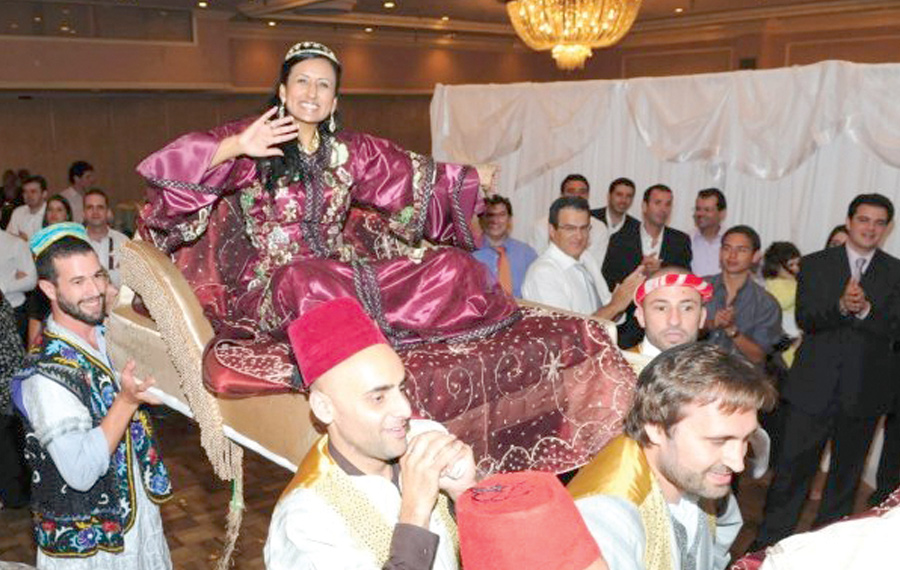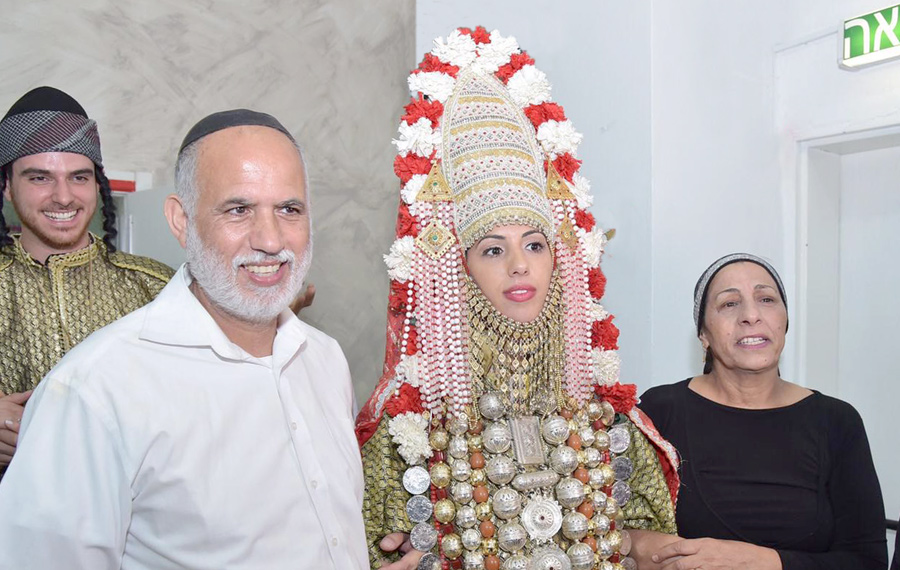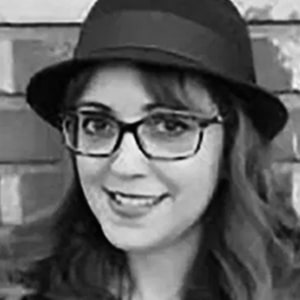 Moroccan-robed bridal party at Esther and Daniel Bengio’s 2008 henna ceremony. Photo by Nejati Studio
Moroccan-robed bridal party at Esther and Daniel Bengio’s 2008 henna ceremony. Photo by Nejati Studio Mizrahi Jews from the Middle East and North Africa have practiced pre-wedding henna ceremonies for generations. The tradition is a symbolic way to shower the bride and groom with what they hope will be many years of protection, health and fertility. Today, henna celebrations often are held a few days before the wedding, though some, like Esther and Daniel Bengio’s henna party, are held on their wedding day.
Dressed in traditional Moroccan attire, Esther and Daniel were lifted up on ottomans like a king and queen and carried into a ballroom by four men wearing red fez hats. They were treated to joyful music and dancing before being ushered into a small, embroidered red tent with Moroccan lamps. Female relatives smeared their palms with henna dye before wrapping their hands in cotton pads and red ribbon.
Their friends and family, many of whom also were dressed in long caftans, fez headdresses and colorful, gold-embroidered robes and headpieces clapped and yelled. The animated women shouted the “Lililili!” sound that is commonly associated with Sephardic and Mizrahi celebrations. In Persian, the sounds are called “kell,” and they’re reserved exclusively for milestone events like weddings and births.
Daniel was born to Moroccan Jewish parents in Spain, and U.S.-born Esther wanted to honor Daniel’s heritage. Esther’s family participated in the ceremony, wearing traditional Moroccan attire and carrying decorative plates filled with sweets.
“It was a magical evening for everyone who attended,” Esther said. Her non-Jewish relatives “thought they were in a re-enactment of [Disney]’s ‘Aladdin’ and still talk about the party to this day,” she added.

Sephardic and Mizrahi communities around the world continue to keep this dynamic tradition alive to the delight of many of their Ashkenazi guests, some of whom have never attended a henna party and who continue to scrub the henna stain off their palms in frustrated wonder for days after the ceremony.
On the night of the henna party for my sister and her French-Tunisian husband, my mother complained loudly that the dye would never wash off before the wedding. She was right.
Some people are familiar with the concept of henna from the Indian body art known as mehndi, an ancient practice in the Indian subcontinent and the Middle East. One difference between mehndi, which is often done at Hindu weddings and festivals, and the Jewish henna ceremony is that the former involves intricate designs on the hands (and sometimes feet) while the latter consists less of artwork patterns. Instead, a small ball of solid henna dye is place on a cotton pad and wrapped around the palm with decorative ribbon. The bride and groom then raise their palms together in a show of joyful unity. It also makes for an excellent photo op.
Brooke Korda, a 31-year-old acupuncturist from Pico-Robertson, always knew that she wanted a henna party. Korda’s father is Persian and her mother is Ashkenazi, while her husband’s mother is Greek and his father is Hungarian. During their 2016 ceremony, her non-Persian in-laws were “totally out of their element but they really did enjoy themselves,” she said.
Couples who hold henna ceremonies see the event as a bridge between familial generations. Dallas-born Liat Nourafchan, 24, lives in Los Angeles but had her henna party in El’ad, Israel, in 2015. Nourafchan’s father is Persian and Russian and her mother is Yemenite, while her husband is Italian-Persian.
Yemenite henna celebrations are often “bigger than the wedding,” said Nourafchan, who donned a traditional Yemenite bridal headdress covered in red and white carnations and real gold.
In Israel, brides who wish to have Yemenite henna ceremonies often borrow headdresses and gold jewelry from older Yemenite women who lend such treasures, many of which are family heirlooms dating back several generations. These elderly women attend the events and ensure that every single one of their precious pieces is accounted for.
“It was important to me to be able to do the same thing my mother’s family was doing for many generations,” Nourafchan said. “The customary dress is a lot more than one would expect. Wearing around 50 pounds of gold all over your body [while] trying to dance is very difficult.”
A highlight of her henna ceremony was when her now late grandmother sang a traditional Yemenite song in Arabic. The lyrics offered comfort for a nervous bride and her grandmother’s presence meant that three generations of Yemenite Jewish women took part in the ceremony.
“I think on an emotional level, this was more meaningful than the actual wedding,” Nourafchan said. “Weddings happen all the time, but it is very rare for a full-bred American to be raised the way that I was and I want to continue the tradition. I only hope my daughters wish to do the same.”
In Los Angeles, there is no shortage of local vendors who offer everything from attire for the bride and groom (and their family and friends) to furniture, lighting and even Moroccan teacups for those who want to hold a traditional henna ceremony. They also provide the henna.
As Nourafchan’s Yemenite grandmother sang during her granddaughter’s henna party, “You get married and you will have everything you need.”
Read more from the 2018 Chuppah Edition here.























 More news and opinions than at a Shabbat dinner, right in your inbox.
More news and opinions than at a Shabbat dinner, right in your inbox.